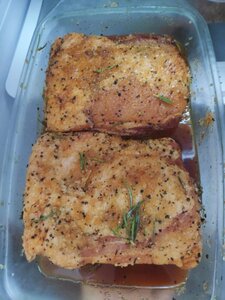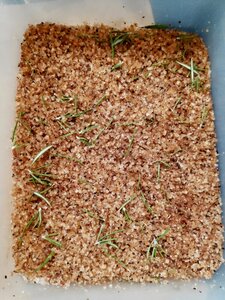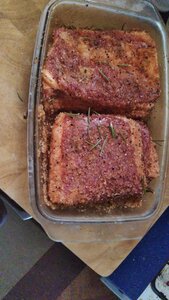- Aug 10, 2020
- 4
- 0
Hey everyone, lurking around here for the last few days since I started making jerky and bacon lately.
Getting your hands on expensive bacon in Israel is extremely hard and very expensive, so I'm making my first bacon.
it's dry curing in coarse salt, brown sugar, black pepper, maple syrup, liquid smoke, bay leaves, rosemary, and crushed garlic cloves - All unmeasured.
I'm so excited that I flip and massage it every few hours, and a lot of liquid has accumulated which I guess is a good sign.
I have some things I want to understand better, feel free to answer what you want and skip the rest.
My questions are:
1. How long should I cure it?
2. Does it change if I live it longer? I have two cuts, should I try leaving one for longer?
3. Should I bake it in the oven after curing? What happens if I do and what happens if I don't?
4. It's curing uncovered in a pyrex dish, should I cover it?
5. Should I soak it after curing? There's a lot of salt.
6. Should I freeze what I don't want to use soon? Doesn't it get worst if I freeze?
7. Should I let it rest in the fridge between rinsing and baking, or is that only relevant when you have a smoker?
8. How long does it really last in the fridge?
Thanks a lot in advance, this is an awesome forum and looks like the community is super helpful!
Getting your hands on expensive bacon in Israel is extremely hard and very expensive, so I'm making my first bacon.
it's dry curing in coarse salt, brown sugar, black pepper, maple syrup, liquid smoke, bay leaves, rosemary, and crushed garlic cloves - All unmeasured.
I'm so excited that I flip and massage it every few hours, and a lot of liquid has accumulated which I guess is a good sign.
I have some things I want to understand better, feel free to answer what you want and skip the rest.
My questions are:
1. How long should I cure it?
2. Does it change if I live it longer? I have two cuts, should I try leaving one for longer?
3. Should I bake it in the oven after curing? What happens if I do and what happens if I don't?
4. It's curing uncovered in a pyrex dish, should I cover it?
5. Should I soak it after curing? There's a lot of salt.
6. Should I freeze what I don't want to use soon? Doesn't it get worst if I freeze?
7. Should I let it rest in the fridge between rinsing and baking, or is that only relevant when you have a smoker?
8. How long does it really last in the fridge?
Thanks a lot in advance, this is an awesome forum and looks like the community is super helpful!








